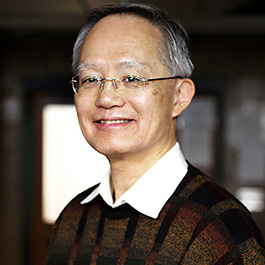Harold Kung, Materials for Higher Performance Batteries
 How much is better battery technology worth? At least $4 million, according to the Big Three automakers.
How much is better battery technology worth? At least $4 million, according to the Big Three automakers.
That’s the size of the contract the U.S. Advanced Battery Consortium — made up of Ford, GM and Fiat-Chrysler — awarded last June to SiNode Systems a battery technology startup founded in 2012 by graduate business and engineering students at Northwestern.
SiNode, renamed NanoGraf Technologies in 2018, produces a novel type of anode for lithium-ion batteries, the kind used in cellphones and electric cars – hence the interest from automakers. Anodes are the part of the battery that hold a charge, a key specification for consumers. NanoGraf is developing an anode made of silicon to replace the typical graphite anodes, allowing for longer-lasting and faster-charging batteries.
The underlying technology for the battery was developed in the lab of Harold Kung, who addressed the robustness of silicon. Silicon tends to expand and contract during charge and discharge, which rapidly degrades battery performance. Kung, the Walter P. Murphy Professor of Chemical and Biological Engineering in the McCormick School of Engineering, mitigated the problem by wrapping nanometer-size silicon particles in graphene, a highly flexible and conductive layer of carbon atoms.
"We are bullish on lithium-ion," former SiNode CEO Samir Mayekar, a graduate of the Kellogg School of Management, told Greentech Media. "The materials that have the greatest chance of getting to market soonest and making a difference are in the lithium-ion ecosystem."
NanoGraf now employs over 20 people and is close to commercialization. In 2014, the company inked an agreement with a subsidiary of the German conglomerate Merck, which allowed the then SiNode to manufacture products for its first commercial customers.
NanoGraf blossomed into a full-fledged venture thanks to Northwestern’s interdisciplinary focus. The initial team started with six graduate students, three from Kellogg and three from McCormick.
“They transformed a technical idea into a viable and attractive business plan and presented it successfully to investors,” said Kung, who serves on NanoGraf’s advisory board. “It has been gratifying to see the growth of the students involved.”
NanoGraf has received several grants and awards, including from the U.S. Department of Energy, the Clean Energy Trust and the U.S. Office of Energy Efficiency and Renewable Energy.
The company received accolades from Chicago Mayor Rahm Emanuel who stated, “By developing clean energy technology, [it] is helping to give more residents from all parts of Chicago an opportunity to participate in the 21st-century economy. I look forward to watching them continue to grow and provide good-paying jobs for more Chicagoans in the years ahead.”